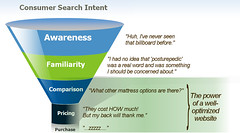By Carl Weiss
Listen to internet radio with workingthewebtowin on BlogTalkRadio
Who would have thought when Robert Noyce invented
and patented the silicon based integrated circuit way | English: Microchips (EPROM memory) with a transparent window, showing the integrated circuit inside. Note the fine silver-colored wires that connect the integrated circuit to the pins of the package. The window allows the memory contents of the chip to be erased, by exposure to strong ultraviolet light in an eraser device. Uploaded by Richard Wheeler (Zephyris) 2007. (Photo credit: Wikipedia) |
back in 1959 that the
world would forever more be changed.
While the initial uses for the computer chip were initially limited to
big business and military applications, within a dozen years, the computer
revolution would enter consumer electronics with the founding of Apple
Computer. Since then the integrated
circuit has become part of virtually every consumer electronic gadget from
cellphones and televisions to the cars we drive. Just when you think that just about every
possible application has been thought up, some enterprising entrepreneur comes
up with another use for the computer chip.
While there are a number of useful creations such as medical prosthetics
that have been known to improve the quality of life for many, what I want to
bring to you today are the “out there” applications that seem to be some sort
of technological outgrowth of the lunatic fringe.
Two
Delicious Drones
While aerial drones are nothing new, there are at
least two engineers are planning on using them to make the term “to go” mean
entirely something new. The Burrito
Bomber is the brainchild of Yoni De
Beule and John Bolles. The pair used a
3-D printer to create their own custom-made bomber that is designed to carry
and air drop burritos via parachute. (I
am not making this up.) The aircraft is
directed to its destination via GPS and can be operated either autonomously or
via remote control.
What’s even more
alarming about this development is that the Burrito Bomber isn’t the only
flying fast food to hit the scene. In a
much publicized YouTube video, Domino’s Pizza demonstrated the DomiCopter
making an aerial pizza delivery in the UK.
Sadly, anyone hoping for an aerial munchies
fix will have to keep hoping for a while. The Burrito Bomber is currently just
a prototype. Current Federal Aviation
Administration regulations prohibit commercial use of unmanned aircraft, but
that could change. "Pending
regulations from the FAA in 2015, we'll be able to drop a burrito to a
neighborhood near you," says Boiles.
RoboRoach
This might not be the best segway in the world,
going from food to bugs, but here is another outlandish example of what can be
done with a computer chip and way too much time on your hands. While many people consider cockroaches a nuisance
that should be eradicated at all cost there are at least two PhDs that think
otherwise. Backyard Brains co-founders Greg Gage and Tim Marzullo both
have doctorates in neural engineering.
Where most of their colleagues use their education to discover ways to
connect human beings to electronic devices such as prosthetic limbs, cochlear
implants and the like, Gage and Marzullo decided to pursue an entirely
different career path. They decided to
form a company dedicated to inspiring scientific curiosity.
The company, established in 2009, sells
low-cost kits to turn any and all interested amateurs into neuroscientists.
(The company's bread-and-butter product is the SpikerBox, an electrophysiological contraption
that allows you to record the brains of insects in real time.) And the
RoboRoach, according to the creators, employs the same neuraltechnology used in
treatments for Parkinson's as well as the make-up in cochlear implants. Now, to
be clear, the RoboRoach is not the answer to the diseases; but it's meant to be
a font of inspiration.
I won’t tell you what is required to robotize a
roach, since it makes me queasy just to think about it. But fret not, because the guys from Backyard
Brains have created a step-by-step video that will take you through the medical
procedure should you be so inclined. Can you say ewwww?” http://youtu.be/5Rp4V3Sj5jE
BugBots to the Rescue
If robotic Roaches weren’t weird enough, there are
several universities currently pursuing insect inspired robots that scuttle,
slither and fly.
In a team led by
graduate students Kevin Ma and Pakpong Chirarattananon, Harvard Microrobotics
Laboratory has created tiny, housefly-sized robots for the purpose of studying
insect flight. Small flying insects like
flies are capable of extremely agile maneuvers, such as dodging out of the way
of an incoming fly swatter, or landing on flowers and grass that are moving in
the wind — making their flight difficult to replicate in a laboratory
condition. But by using some unconventional approaches to propulsion,
manufacturing and actuation, the Harvard Microbiotics team — after a decade's
work — has been able to create a robot that can hover on the spot, take off
vertically and steer. They're called RoboBees.
Currently used
as a flight demonstration system due in part to the fact that the RoboBees need
to be tethered to an off-board power source, the design team looks forward to
the day when their robotic insects can take wing on their own for everything
from crop pollination to search and rescue missions.
Not to be
outdone, other researchers at Harvard
Microrobotics have come up with the Harvard Ambulatory Micro Robot, otherwise
known as the HAMR. Utilizing the same
fabrication process used to create the RoboBee, the HAMR weighs in at just 1.3
grams and while they can’t fly, they can scuttle along at 37 centimeters per
second. While the developers of the HAMR
have as of yet to come up with an actual use for the tiny robots, the
researchers claim that they are cool to have around.
What’s Next?
While a quick search of Google and Kickstarter is a
good way to get a bead on the far out uses of the microchip, only time and
imagination will show what wondrous and wacky inventions will be spawned next
from a sliver of silicon. (Personally, I
think there is soon going to be a pressing need for an autonomous flyswatter that is designed to
combat the coming onslaught of bugbots.)
Carl
Weiss is president of W Squared Media Group, a company that helps entrepreneurs
develop their products by offering an array of funding, design and marketing
services. You can also hear about some
of the other weird, wonderful and wacky inventions that the integrated circuit
has wrought on Carl’s Working the Web to Win radio show live at 4 pm Eastern
today.












